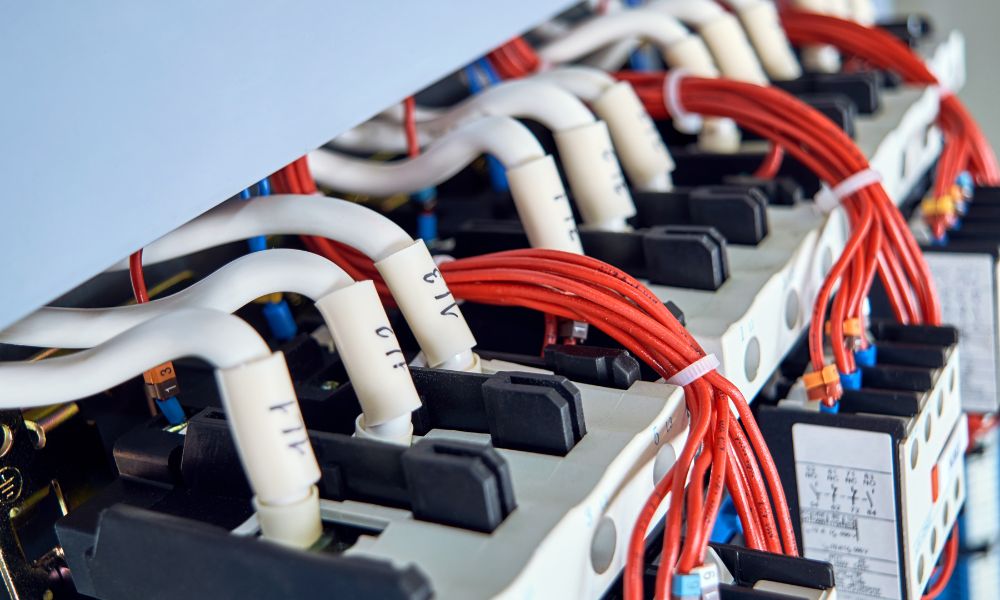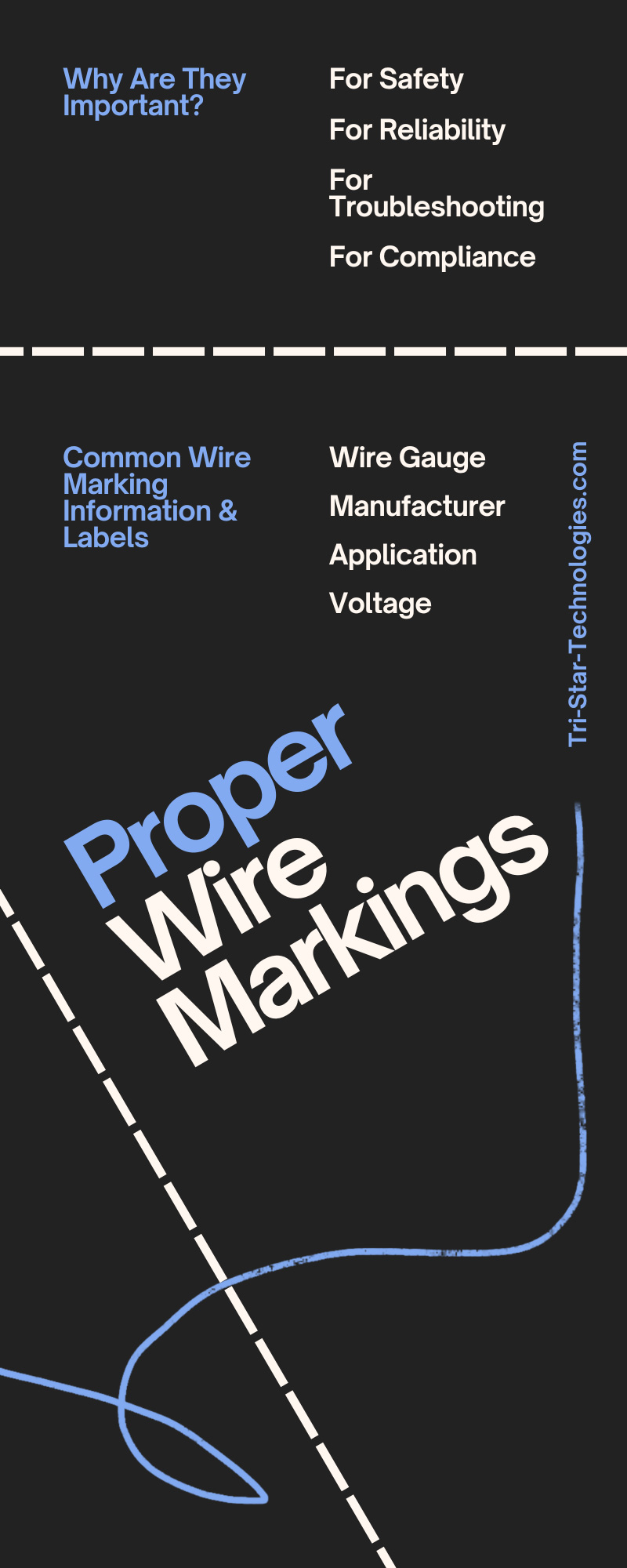Understanding the Importance of Proper Wire Markings

Often, the smallest labels and markings are the most important. Wire markings serve many purposes, from compliance to safety and troubleshooting. Below, we explain the importance of proper wire markings, so those interested can better understand their significance and some standard markings typically found on wires.
WHAT ARE WIRE MARKINGS AND WHY ARE THEY IMPORTANT?
Markings serve many purposes and are essential labels for wires in every type of facility, from businesses to residential homes. As nice as it would be, we can’t just install necessary electrical wires one time and then forget about them.
For the safety, reliability, compliance, and future problem-solving of the system and wires, it’s important to understand proper wire markings.
For Safety
The primary reason that wire markings are so crucial is that it ensures the wires’ safety and the safety of the entire building system. Although electrical wires are present in every type of building, they can still be dangerous—especially if they’re not handled correctly due to mislabeling.
If a wire gets mistakenly cut or unplugged, it can cause a cascade of dangerous events that severely injure electricians and other individuals and even cause fires. We’ve all heard and seen what an electrical fire can do to a building—and wire markings are essential safety labels to prevent electrical fires.
For Reliability
Wire markings are not only for the safety of the building but also for the system’s reliability and an electrician’s convenience when working on and fixing it. In our modern world, practically every facility requires copious amounts of electricity and data to run correctly, and all that electricity means many wires going in all directions throughout a building.
When you need to install or remove electrical equipment or adjust the wires and system, there’ll undoubtedly come a time when a technician must cut or remove a wire. But if the wires aren’t properly marked, how can an electrician know which wires to cut or unplug? A wrongfully cut wire is dangerous and can cause major system failures for the entire facility, inconveniencing everyone.
For Troubleshooting
As we all know, many electrical problems can arise in buildings full of these wires and cables—issues requiring going into the system and adjusting the wires. Troubleshooting is an inevitable part of these systems, but it’s much more complicated without properly marked wires.
Without marked wires, electricians must meticulously and painstakingly trace the path and origin of hundreds or thousands of wires in a system to find the problem and develop a safe solution. When the wires are correctly marked, this problem-solving process is much easier and quicker for everyone, so issues get fixed faster and at less cost.
For Compliance
Advantages of wire markings to the individual aside, there’s also a legal obligation to provide safe and reliable markings on wires. OSHA requires that business owners maintain a safe facility for employees while working, and wire markings are crucial to electrical safety.
Suppose faulty wiring or malfunctioning wires cause a fire or other danger in a facility that threatens workers’ safety, and it’s proven the wires lacked proper markings. In that case, the owner could be liable or found negligent. For the good of the facility and all those who inhabit it, mark all wires and cables.
ARE WIRES DIFFERENT THAN CABLES?
You may notice that we commonly refer to wire and cable markings interchangeably, but we don’t want to confuse people as they don’t mean the same thing. While we may use cable and wire interchangeably in everyday life, a wire is an individual, insulated conductor in an electrical environment. In contrast, a cable assembles two or more wires within a jacket.
In basic terms, a cable has a jacket or sleeve that holds the wires together. While the markings we discuss below are for wires, cables can also have markings on their jackets with crucial information regarding the wires within.
COMMON WIRE MARKING INFORMATION & LABELS
A few typical wire markings are worth knowing for even people outside the electrical industry, and we’ll explain some of the standard labels found on wires below.
Wire Gauge
The first label is the wire gauge, which is the series of numbers and letters printed on a wire. Typically marked as “XX AWG” for American wires, the number describes the thickness of the conductor.
The succeeding “AWG” stands for American Wire Gauge, the prevailing measurement standard used in America. In other countries, like Canada, they’ll typically have their standard, but practically any wire an American electrician will work on will have the AWG label.
Manufacturer
Next to the wire gauge is the UL file number. This file number doesn’t give any information regarding the individual wire but marks the manufacturer—represented by a six-digit number with letters followed by “UL.”
UL stands for Underwriters Laboratory and is the third-party testing laboratory that certifies and tests the wires used. If an electrician needs to know where this wire came from, they can check the UL file number and track its origin. If operating in Canada or the wire comes from a Canadian manufacturer, it may get marked “CSA” for the Canadian Standards Association.
Application
Next to the file number comes a three-letter designation from the UL (or CSA) that labels the safe application for the wire. Usually, the marking will be Machine Tool Wire (MTW) or Thermoplastic Equipment Wire (TEW) for Canadian-manufactured wires.
Voltage
Perhaps the most critical label on a wire is the voltage ratings, often found directly after the MTW label. Understanding the wire’s voltage ratings is essential to electrical safety and is a number followed by a “V,” such as 600V or 1000V.
The insulation thickness and the wire conductor gauge determine the voltage rating.
HOW TO ENSURE PROPER WIRE MARKINGS
Proper wire markings are vital, but how does one ensure that the wires in their buildings are adequately marked? A reliable wire marking system ensures that labels get printed on the wire clearly and permanently so that they’re still legible and reliable no matter how many years pass.
Tri-Star Technologies offers many of these systems and a helpful team to answer any questions or help you find the right marking system for your needs. Contact the experts at Tri-Star for a reliable and valuable wire marking machine today!



